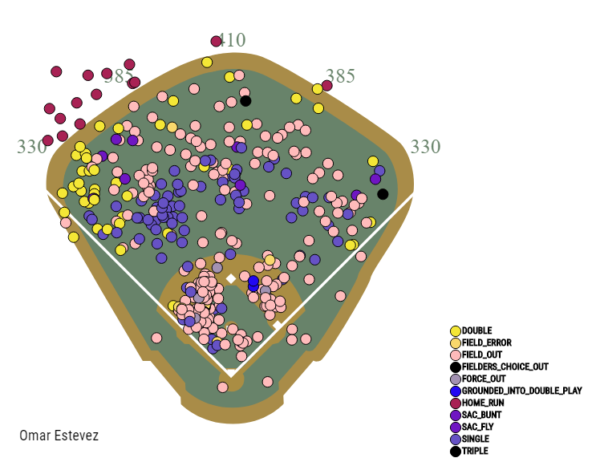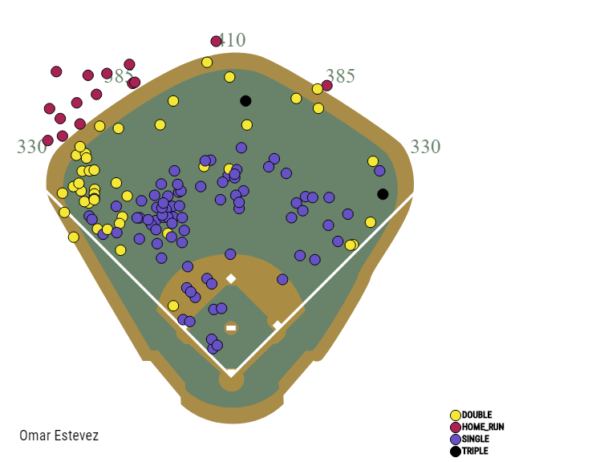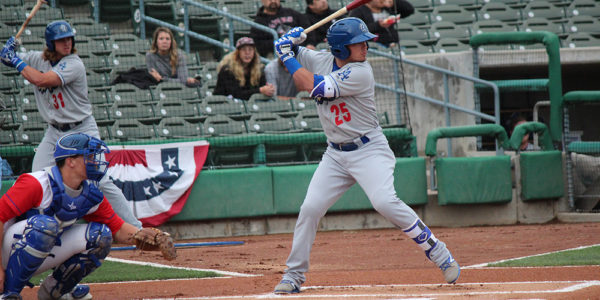We have reached the Top 10 in the Dodgers Digest Top 100 prospects. We’re doing things a bit differently this year, as the Top 10 will be individual profiles of each player. We start with No. 10, shortstop/second baseman Omar Estevez.
——
Previously
——
I’ve included Future Value (FV) grades and risks for the Top 50 prospects. For example, if a guy gets a “50 low,” he has a really good chance to be an average player at his position. If a guy gets a “55 high,” there’s a good chance he won’t reach that ceiling, but the potential is there. I tend to give higher future values because I take ceiling into account. The grades are 20-80 (50 is average), and the risks are as follows:
- Low: Players who are usually older, have debuted, are relievers and/or have higher floors than ceilings
- Medium: Players who are a mix of younger and older, usually have higher floors
- High: Players who are usually younger with potential, but also question marks
- Extreme: Players who are younger with star potential, but a ton of question marks
This is to show what value a player might provide at the MLB level. The higher the risk, the less likely a player will reach that ceiling.
——
Editor’s Note: I am not a scout (#notascout). I am an amateur when it comes to evaluating players. I don’t claim to be a pro, I just want to pass along the information I observe/obtain to the people. Notes and comments are based on personal observation, talking to sources, reading scouting reports and watching video. For future entries in this series: All ratings in the charts below are on the standard 20-80 scouting scale, where 50 is roughly average, 80 is elite and nearly unattainable and 20 is unacceptably poor. Enjoy.
Other notes: “Role” is a realistic future role (slightly optimistic in some cases). Age is the 2019 season age for the player (June 30 is the cutoff date).
——
Rating Key
| 80 – Elite |
| 70-75 – Plus-plus |
| 60-65 – Plus |
| 55 – Above-average |
| 50 – Average |
| 45 – Fringe-average |
| 40 – Below-average |
| 30-35 – Poor |
| 20-25 – Very Poor |
——
10. Omar Estevez
| DOB: 2/25/98 | Age: 21 | Height: 5’10 | Weight: 197 | Bats: Right | Throws: Right | Position: SS/2B |
| Tools | Now | Future |
| Hit | 40 | 55 |
| Power | 35 | 45 |
| Speed | 45 | 45 |
| Defense | 45 | 55 |
| Arm | 45 | 50 |
| FV/Risk | 55 | High |
| Type of hitter: Advanced, Line drive-focused, developing power, good bat-to-ball | ||
Acquired: International free agent (Cuba), November 2015, $6 million signing bonus
Physical description: Short, stocky, packs a punch, not much projection left
Strengths: Consistently barrels up pitches, learning to elevate, has instincts/hands to play shortstop
Weaknesses: Not ideal arm for shortstop, fringy power (all to pull side), not speedy
Key statistics: .278/.336/.456, 7.8 BB%, 23.9 K%, .179 ISO
Summary: Estevez broke out in his second full season in the California League. While his walk- and strikeout rate went the wrong direction, he put the bat on the ball more and hit it with more authority. His batting average jumped 22 points and his his isolated power went up 87 points — no small feat, even in the Cal League.
At the plate, Estevez has the look of a professional hitter. He has some movement in his hands pre-swing as he brings them down into his load. He has a big leg kick and load that looks like it should be more powerful than it actually is, but Estevez has tapped into his power a bit in 2018. Frequently compared to Howie Kendrick, offensively, his ’18 mirrored a Kendrick-like season, and that’s probably his offensive ceiling at the MLB level, if he can continue to elevate the ball. He’s a pull-happy hitter, which is where most of his power is. But, he can hit the ball the other way, and he did that more in his hot second half. He’s disciplined enough at the plate that he won’t be a free-swinger, giving him a chance to be an above-average middle infielder.
When he was signed, Estevez profiled as a second baseman only. Since turning pro, though, he has gotten a lot of time at shortstop and now, looks like he might be able to stay there longer than expected. He lacks ideal arm strength for shortstop, but his soft hands and quick actions help him make up for that. He doesn’t have a ton of range overall, but he makes enough plays to stay there for a bit. If he has to move to second base full-time, his arm should play up a bit and he could be an above-average defender there. His speed isn’t much of an asset, as he has stolen just 8-of-17 bases in his 3-year career.
Estevez could be an up-the-middle starter for a first-division team, mainly because of his bat. He has some defensive value, but his bat will be the carrying tool. He’ll will be challenged at Double-A Tulsa, as most prospects are. If he can do as well against Texas League pitching as he did against Cal League pitching, he could be a more premium prospect heading into next season.
Spray Charts


Videos
2018 Ranking: 30
2019 Location: Double-A Tulsa
ETA: 2021
Next Up: Prospect No. 9
 Dodgers Digest Los Angeles Dodgers Baseball Blog
Dodgers Digest Los Angeles Dodgers Baseball Blog
